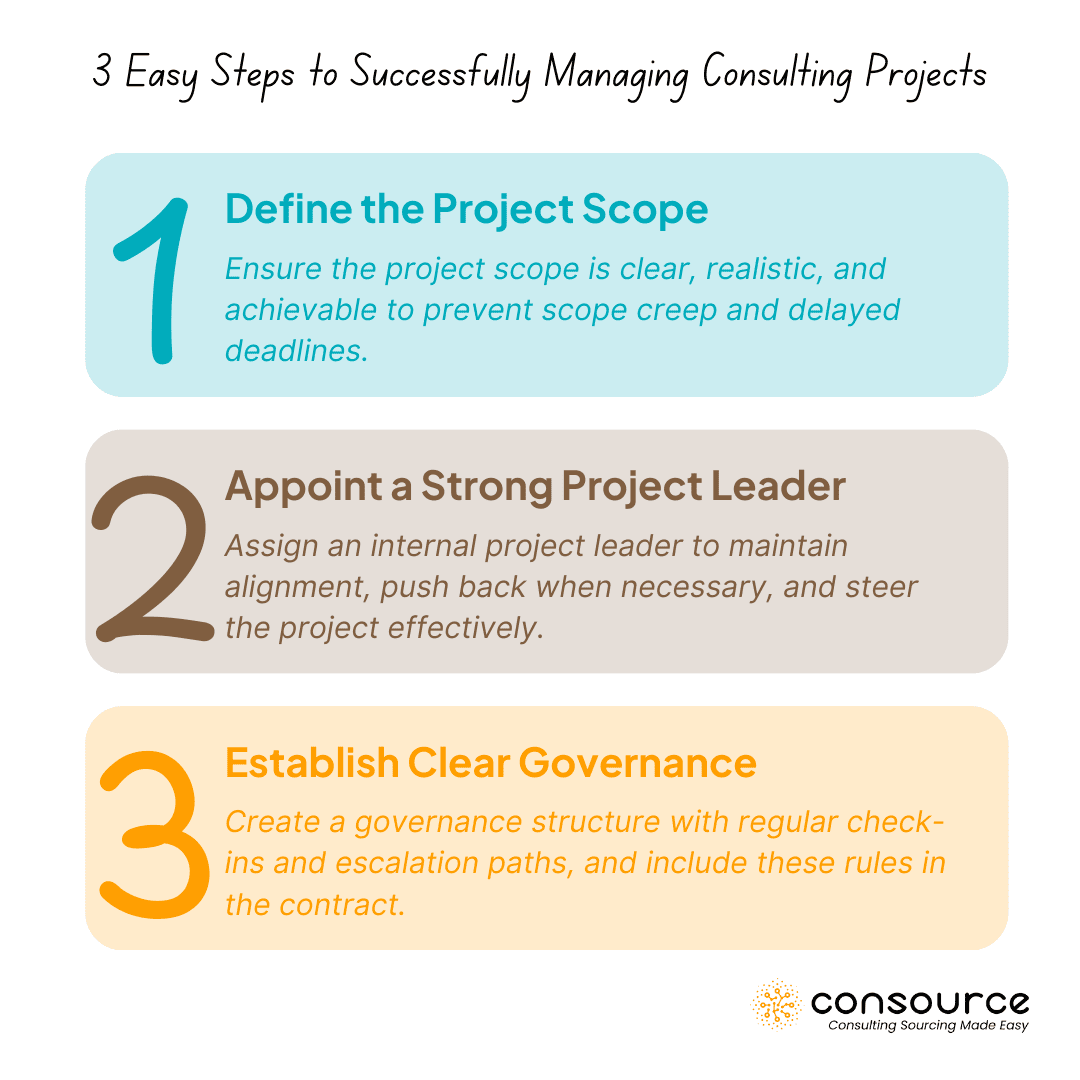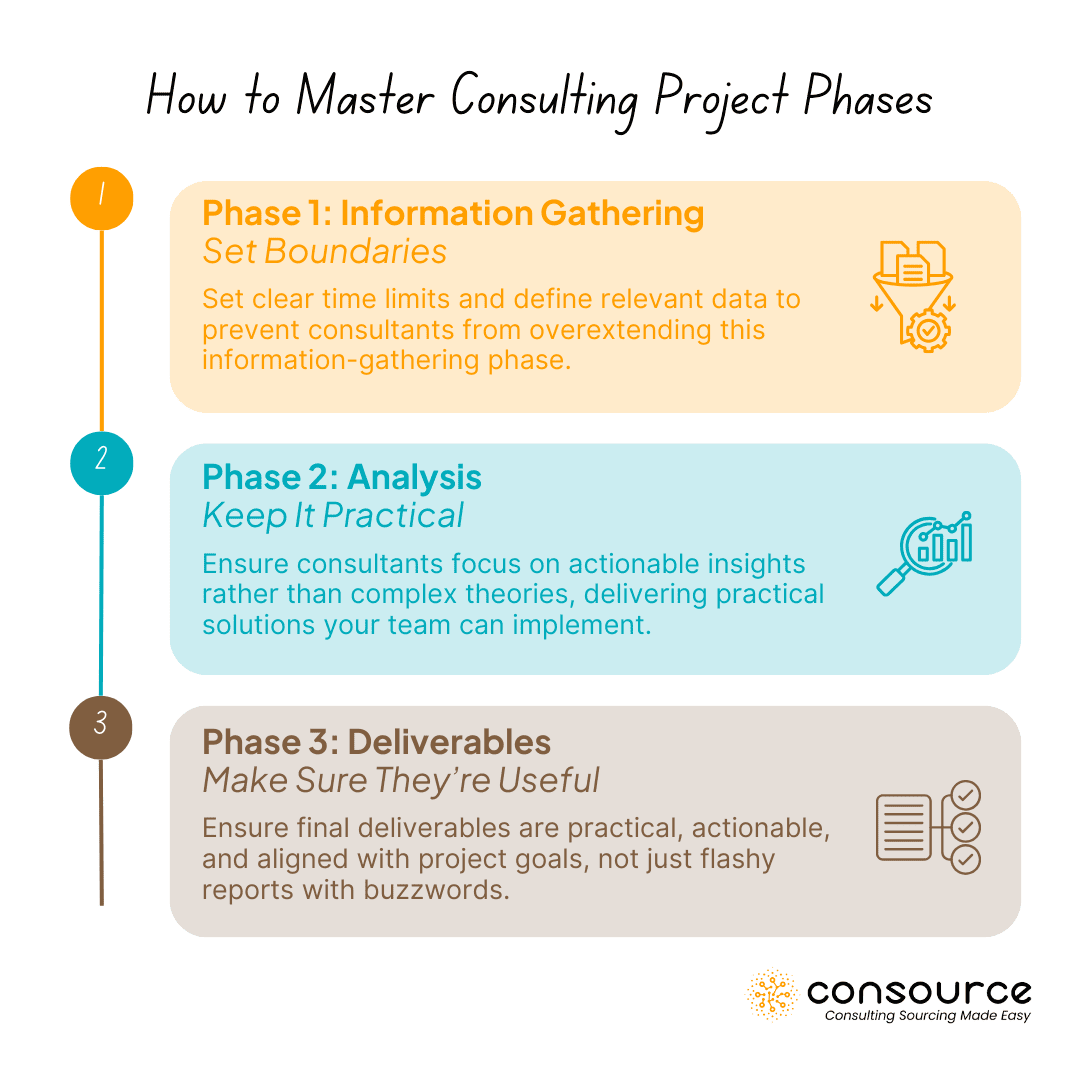Para gerenciar um projeto de consultoria, pode ser como tentar pastorear gatos e, ao mesmo tempo, equilibrar o orçamento e o cronograma. Como cliente, você está sentado no banco do motorista, mas é fácil sentir que os consultores são os que estão com as mãos no volante, conduzindo o projeto em direções inesperadas. Eles vêm equipados com slides sofisticados, palavras-chave do setor e recomendações brilhantes, mas, como quem paga a conta, sua sanidade (e seu orçamento) depende da garantia de que eles forneçam resultados reais, não apenas promessas brilhantes.
Então, como manter o controle ao gerenciar projetos de consultoria, garantindo que o processo não se transforme em um caos? A verdade é que tudo se resume a definir o tom desde o início e garantir que você mantenha as rédeas firmemente em suas mãos. Seguindo algumas estratégias essenciais, você pode manter seu projeto de consultoria no caminho certo, evitar desvios de escopo e garantir que o produto final seja algo que sua equipe realmente usará.
Estamos prestes a orientá-lo exatamente sobre como fazer isso - sem se desesperar ou jogar seu orçamento pela janela.
#1. Estrutura e abordagem do gerenciamento de projetos - Organizando para a sanidade (e o sucesso)
O primeiro passo para gerenciar com sucesso projetos de consultoria é colocar seus planos internos em ordem. Antes mesmo de os consultores entrarem em seu escritório, você precisa definir uma estrutura clara de gerenciamento de projetos, alocar os recursos certos e estabelecer uma governança que funcione para a sua equipe. Lembre-se: só porque os consultores estão liderando o trabalho em determinadas áreas, isso não significa que você está entregando as chaves do castelo. Ainda é você quem está dirigindo.
Defina o escopo - mantenha-o realista
É fácil se deixar levar pela empolgação com o que os consultores podem oferecer, mas sejamos realistas: se o escopo não for claramente definido desde o início, você terá que enfrentar uma montanha-russa de revisões intermináveis e prazos atrasados. Como cliente, é sua responsabilidade definir um escopo do projeto que seja ambicioso e factível. Não deixe que os consultores o vendam em excesso com resultados que parecem ótimos no papel, mas que podem não agregar valor real aos seus negócios.
Nomeie um líder de projeto forte - você precisa de um capitão
Embora os consultores possam agir como se estivessem comandando o navio, você precisa de alguém do seu lado que esteja dirigindo o curso. Nomeie um líder de projeto forte de sua equipe interna - alguém que conheça os meandros de sua empresa e que possa reagir quando necessário. Essa pessoa atuará como elo de ligação entre a sua equipe e os consultores, garantindo que o projeto permaneça alinhado às suas metas de negócios e evitando que os consultores saiam pela tangente.
Estabeleça uma governança clara - as regras do jogo
Os consultores são profissionais, mas vamos encarar os fatos - eles também estão lá para administrar um negócio. É seu trabalho garantir que eles sigam suas regras. Estabeleça uma estrutura de governança sólida que inclua check-ins regulares, revisões de marcos e um caminho de escalonamento claro para quando as coisas (inevitavelmente) saírem dos trilhos. E aqui vai uma dica profissional: certifique-se de que essa governança esteja definida no contrato. Dessa forma, se o desvio de escopo começar a aparecer, você terá a documentação para controlá-lo.
Lembre-se: gerenciamento de projetos de consultoria não se trata de microgerenciar os consultores; trata-se de ter os processos corretos para garantir que eles forneçam o que você precisa, quando você precisa, sem que o seu projeto entre em parafuso.

#2. Gerenciamento de participantes-chave e comunicação eficaz - Mantenha todos (inclusive os consultores) na mesma página
Quando a estrutura do projeto estiver pronta, é hora de reunir os principais participantes, tanto dentro da sua equipe quanto entre os consultores. Um dos maiores erros que os clientes cometem ao gerenciar projetos de consultoria é presumir que todos estão na mesma página. Spoiler: provavelmente não estão. Cabe a você garantir que a comunicação seja clara, consistente e, acima de tudo, frequente.
Alinhe as partes interessadas com antecedência - evite surpresas de última hora
Antes que os consultores comecem a fazer sua mágica, certifique-se de que todas as principais partes interessadas de sua organização entendam as metas do projeto e apoiem a abordagem. É nesse ponto que muitos projetos saem dos trilhos. Um projeto é lançado por um executivo bem-intencionado, mas depois fracassa quando os principais interessados não estão a bordo. A última coisa que você quer é chegar à metade do projeto e descobrir que um participante importante não aderiu ao plano.
A adesão das partes interessadas não é apenas uma caixa de seleção - é essencial. Envolva-os desde o início, comunique a justificativa comercial e aborde quaisquer preocupações que eles tenham logo de início. Você agradecerá a si mesmo mais tarde, quando não estiver lutando para conseguir apoio no meio do projeto.
Comunicação regular - Pare o silêncio
Os consultores são especialistas em fazer apresentações em PowerPoint e sair pela porta, deixando sua equipe para descobrir as próximas etapas. Não deixe que isso aconteça. Estabeleça canais de comunicação regulares para garantir que todos - tanto da equipe de consultoria quanto das partes interessadas internas - permaneçam informados. Reuniões semanais de status, atualizações claras do progresso e sessões abertas de feedback podem evitar que pequenos mal-entendidos se transformem em problemas maiores.
E aqui está uma regra de ouro da comunicação: não presuma que eles sabem o que você está pensando. Explique tudo claramente e peça o mesmo em troca. Afinal, o projeto é seu e você merece saber exatamente o que está acontecendo o tempo todo.
#3. Gerenciamento de projetos - Busque as melhores práticas (e mantenha o caos sob controle)
Depois que todos estiverem alinhados e comprometidos com o projeto, a próxima etapa do gerenciamento de projetos de consultoria é mergulhar nas práticas recomendadas clássicas de gerenciamento de projetos. E por "práticas recomendadas", queremos dizer estratégias que evitam que o seu projeto se transforme em um jogo de telefone em que ninguém está na mesma página.
A chave para o sucesso? A plano de trabalho que realmente funciona.
Desmembrar - A arte de não complicar demais
Já ouviu falar do amor de um consultor pela complexidade? Isso é real. Mas a questão é a seguinte: a complexidade nem sempre é sua amiga. A base de um gerenciamento de projetos sólido é dividir o trabalho em partes gerenciáveis. Você não precisa de um gráfico de Gantt de dez camadas que somente os consultores possam decifrar. O que você precisa é de um plano de trabalho claro e direto que descreva quem está fazendo o quê e quando - e que você possa realmente seguir sem precisar de um PhD em gerenciamento de projetos.
O plano de trabalho também deve incluir marcos regulares em que você possa verificar e certificar-se de que tudo está ocorrendo conforme o planejado. Dessa forma, você pode detectar problemas antes que eles se tornem desastres completos.
Não deixe que os consultores se tornem desonestos - Pontos de controle regulares
Os consultores são famosos por se desviarem do curso e entregarem em excesso coisas que você não pediu (ao custo do que você realmente precisava). É por isso que os pontos de controle regulares são essenciais. Organize reuniões de status semanais ou quinzenais para analisar o progresso, realinhar as prioridades e, o mais importante, certificar-se de que eles estão entregando o que você realmente precisa.
Se algo não estiver certo, não tenha medo de pisar no freio e corrigir o curso. Lembre-se de que você é o cliente. Se não mantiver os olhos na estrada, os consultores poderão fazer um desvio para mostrar suas novas ideias brilhantes (que, a propósito, você não pediu).
#4. Planejamento das diferentes fases - Faça com que os consultores sigam o roteiro
Agora que você já tem um plano de projeto pronto, vamos falar sobre fases. Os projetos de consultoria tendem a ter várias fases, geralmente começando com a coleta de informações, passando para a análise e, finalmente, terminando com os resultados (geralmente um relatório sofisticado). O problema? Às vezes, os consultores ficam muito presos em uma fase e acabam perdendo tempo que deveria ter sido alocado em outra.
Fase 1: Coleta de informações - Estabelecer limites
A primeira fase trata da coleta de informações, e é fundamental fazer isso corretamente. Mas é aqui que as coisas podem dar errado: os consultores adoram coletar informações. Eles conversam com todo mundo, fazem entrevistas intermináveis e o inundam de dados. Isso é muito bom, mas se você não estabelecer limites, essa fase pode se arrastar para sempre.
Defina expectativas claras quanto ao tempo que a fase de coleta de informações deve durar e certifique-se de que os consultores saibam o que é relevante (e o que não é). Tempo é dinheiro e, se os consultores passarem muito tempo aqui, você acabará com um relatório inchado e uma carteira vazia.
Fase 2: Análise - Mantenha-a prática
Quando os consultores tiverem todos os dados, eles passarão para a análise. E é aqui que as coisas podem se complicar desnecessariamente. Os consultores adoram analisar todos os ângulos, mas você precisa manter as coisas práticas. Sim, a análise é importante, mas não deixe que eles se atolam em buracos de coelho teóricos.
Certifique-se de que a análise se concentre em insights acionáveis - coisas que sua equipe possa realmente implementar. Você não precisa de uma dissertação de 50 páginas; você precisa de soluções que gerem resultados.
Fase 3: Produtos finais - Certifique-se de que sejam úteis
A fase final consiste em apresentar os resultados. Os consultores montarão uma bela apresentação com gráficos sofisticados e conclusões inteligentes. Mas aqui está o ponto crucial: é algo que sua equipe possa realmente usar?
Certifique-se de que os resultados não sejam apenas uma coleção de palavras-chave e slides bonitos. Eles precisam ser práticos, acionáveis e alinhados com as metas originais do projeto. Se não for algo com o qual sua equipe possa trabalhar, será uma perda de tempo para todos (e para o seu orçamento).

#5. Funções e responsabilidades - Quem está fazendo o quê (e quem está recebendo crédito por isso)?
Em qualquer projeto de consultoria, há duas equipes: a equipe do cliente e a equipe do consultor. Embora elas precisem trabalhar juntas, as funções são muito diferentes. É importante definir quem é responsável pelo quê desde o início para que você não acabe jogando um jogo de "não é minha função" quando as coisas derem errado.
Equipe de consultoria: Os "Visitantes"
Os consultores geralmente vêm com uma hierarquia: no topo está o sócio, seguido pelo gerente de projeto e, depois, os consultores ou analistas juniores que fazem o trabalho pesado. O sócio é o rosto da empresa, mas sejamos realistas: ele não está fazendo o trabalho do dia a dia. Os consultores juniores são os que conduzem as entrevistas, analisam os números e montam as apresentações em PowerPoint.
Os especialistas também podem ser chamados para dar credibilidade, mas atenção: eles geralmente aparecem para a apresentação e desaparecem quando o trabalho de fato começa.
Equipe do cliente: A "equipe da casa"
Como cliente, sua equipe também desempenha um papel crucial no sucesso do projeto. Você terá uma proprietário do orçamento que é responsável pelo financiamento do projeto, e um patrocinadorO gerente de projeto, normalmente um executivo sênior, que fornece supervisão de alto nível. Essas funções podem ser combinadas em projetos menores, mas, independentemente disso, é importante ter alguém que possa tomar decisões e manter as coisas em andamento.
Depois, há o gerente de projetos-O herói desconhecido de seu projeto. Essa pessoa é responsável pela coordenação entre a sua equipe e os consultores, certificando-se de que os prazos sejam cumpridos e que os consultores não se tornem desonestos.
O restante da sua equipe será composto pelos principais interessados - pessoas que são direta ou indiretamente afetadas pelo projeto. Eles podem contribuir para o trabalho ou apenas precisar ser mantidos informados, mas sua adesão é essencial para o sucesso do projeto.

#6. O Modelo de Governança Eficaz - Mantenha o Comitê Diretor enxuto e eficiente
Em gerenciamento de projetos de consultoriaNo entanto, um dos elementos mais importantes é a governança. Mas aqui está a armadilha: um número excessivo de pessoas no seu comitê de direção pode interromper o progresso. Mantenha o comitê enxuto e simples. Não convide todas as pessoas que estejam remotamente interessadas no projeto - concentre-se nos tomadores de decisão que podem manter o andamento do projeto.
Comitê Diretor - Keep It Small
O comitê diretor é o órgão decisório final do seu projeto. O ideal é que ele seja composto por cerca de cinco membros, incluindo os principais interessados e executivos. Essas são as pessoas que darão o direcionamento, aprovarão os marcos e intervirão quando o projeto tiver problemas.
Não transforme o comitê diretor em uma reunião da prefeitura. O excesso de vozes na sala impossibilitará a condução eficaz do projeto.
Comitê de Gerenciamento de Projetos - Mantenha o rumo
Enquanto o comitê diretor lida com as decisões gerais, o comitê de gerenciamento de projetos é onde o trabalho cotidiano acontece. Essa é uma reunião recorrente entre a sua equipe e a equipe de consultoria, geralmente realizada semanalmente. É onde você analisará o progresso, abordará quaisquer problemas e se certificará de que tudo está no caminho certo.
É nesse ponto que o seu gerente de projeto precisa brilhar - manter os consultores responsáveis e garantir que eles estejam entregando o que foi prometido.
#7. Gerenciamento de mudanças bem-sucedido - porque a comunicação por si só não é suficiente
Esta é a dura verdade: até mesmo o projeto mais bem gerenciado pode fracassar se você não lidar com a gerenciamento de mudanças lado das coisas. As pessoas resistem às mudanças, seja em um novo sistema de CRM ou em uma reestruturação de departamentos. Como cliente, é seu trabalho prever essa resistência e gerenciá-la desde o início.
Por que a mudança é difícil
Mudanças são assustadoras. Seus funcionários podem se preocupar com o fato de um novo sistema dificultar o trabalho deles ou, pior ainda, torná-lo redundante. Eles podem sentir que sua influência na empresa está sendo prejudicada. Como líder do projeto, é sua função abordar essas preocupações de frente, com uma estratégia de comunicação clara e honesta.
Reforce a mudança desde o início e com frequência
Não espere até que o projeto esteja concluído para começar a falar sobre mudanças. Inclua-a em sua comunicação desde o início. Compartilhe os primeiros sucessos, mostre o progresso e informe às pessoas como as mudanças as afetarão positivamente. Quanto mais você reforçar a mudança, menos resistência enfrentará quando chegar a hora de implementá-la.
Conclusão: Como lidar com projetos de consultoria - Mantenha o controle e a sanidade mental
O gerenciamento de projetos de consultoria não precisa parecer uma batalha difícil e constante. Ao manter-se organizado, manter a comunicação clara e manter o controle sobre o processo, você pode evitar o caos que muitas vezes ocorre com esses compromissos.
O segredo é lembrar que, como cliente, você está no comando. Os consultores estão lá para ajudar, mas o que está em jogo é o seu projeto, suas metas e, em última análise, o seu sucesso. Mantenha as linhas de comunicação abertas, estabeleça limites claros e não tenha medo de dirigir o navio quando as coisas começarem a se desviar do curso.
No final, se você gerenciar bem seu projeto de consultoria, não só atingirá suas metas, como também manterá sua sanidade (e seu orçamento) intactos.








0 comentários